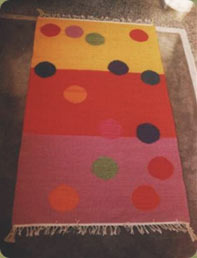Ina attained her Master's of Fine Art at Hunter College New York; and her Bachelor of Fine Arts from the School of Visual Arts, NYC. In addition, she studied industrial design at Ecole Nationale Superieure de Creation Industrielle, France.
Then she took a break during that course to go to NYC's Arts Students League, studying sculpting in stone and marble, and doing a lot of ceramics. Started in the sixties, the place is famous for its non-academic approach.
Following that, she was employed as a professional model with "Company," in NYC and Paris. Of this latter experience she says...
"People always responded to my image, to the "package" they saw me as – extremely tall (even for modeling), smart (which actually wasn't really relevant for modeling!) unusual-looking, and versatile.
"Simultaneously I was painting, and one of my teachers was a curator, Nancy Spector, at the Guggenheim Museum. She loved my work and she wanted to support me, so she invited me to work for her as an assistant. Later on I was the director's assistant at the John Webber Gallery in NY."
§

|
Ina has held exhibitions in Germany, France, New York (Times Square Gallery and the 303 Gallery annually from 1996 to 2000), and Bangladesh.
A young woman making her mark in the world, by anyone's standards. What attracted her to meditation?
After being operated on for a tumor, an operation that adversely impacted her health, she was wary of the western system of medicine, doctors and hospitals, and started to experiment with alternative natural medicine...and with meditation. |
"The whole experience of maybe possibly having to die suddenly, of losing or realizing there is no control at all of my life made me feel like I had really wasted my life by worrying so much, by living in dreams and fantasies and escaping my life all the time. I was so worried about how I looked what I was wearing; I was just totally focused on the outside.
"I felt people didn't know what was inside; people just wanted me to look good and to function. Since I was little I had been able to express whatever was inside of me; but now, in modeling I wasn't able to, I was always presenting a mask, so I felt I was not being true to myself."
|
§
After several operations in France, Ina returned to New York and started therapy and meditation, the latter at the Shambala Center, based on the teachings of the Tibetan master Chogyal Trungpa Rinpoche.
A dose of yoga, macrobiotics, Mantak Chias microcosmic orbit meditations, and psychoanalysis later, she found herself traveling in India.
"I was always searching and I was always in pain, that's how I remember it, and when I came to the to the Osho Meditation Resort I was very much a big mess. But immediately I felt very much at home there. It was as if I had come home, and I never wanted to leave again.
Asked if she meditates every day, Ina responds...
"I do a morning meditation of sitting in silence; this gives a center and focus to my day. Listening to an Osho discourse at the end of each day closes or rounds off everything that has happened through the day.
"The whole meditation has so many different spaces in it. First the dancing phase at the start: sometimes I become disconnected from myself during the day and through dancing, I feel I am coming back to myself. I begin to notice exactly how I am feeling: sometimes suddenly I am crying or I notice I am very happy and laughing.
"Then the phase of sitting down, and listening to the music interspersed with silence is very beautiful. When Osho starts talking – sometimes I follow what he is saying but also I tune into the gaps between the words. |
 |
"When I first started meditating I began to learn that whatever you have – silence or peace, for example – if you give some space around it, it grows. This is how I work in my art. I have to do that; otherwise I can't really see what I'm trying to.
"It's like: when you want to make space in your room, most of the things you don't need and they get in the way of the roominess. Get rid of them and you see and feel the spaciousness better.
"So with my inner space I am learning to let thoughts and feelings go.
"As I listen to the discourse I am trying to receive ... not just words, the content, the story ... I am not trying to intellectually understand but to trust an inner space: who I am, without all the conditioning, all this other 'stuff,' but to contact who I am in a more naked way, in a more natural, innocent space.
§
 |
"At the end Osho always reminds us to be the buddha within us. For a moment we don't have all the 'stuff.' The space inside feels like something holy...something sacred, intimate. I feel the silence as a precious thing that is there inside me: if I don't sit each evening to consciously access this space, I might not pay attention to it. But by allowing it every night I don't forget it so easily. It's not possible to forget it. |
"I know if I didn't do this meditation regularly I would be a lot more crazy! By that I mean: when I am stressed, I can't breathe properly; there is so much to do that feels important. I feel I am not good enough as I am, that I can't be what others want me to be.
"But in meditation I am me – and that's enough." Copyright© activemeditation.com |
 |
§
|



